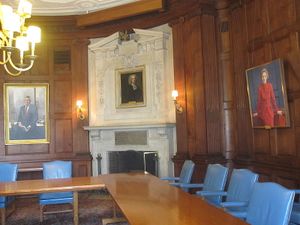Difference between revisions of "Trustees"
(→History) |
|||
| Line 5: | Line 5: | ||
==History== | ==History== | ||
| − | The [[Royal charter]] granted by [[King George II]] in [[1754]] gave power to "the Governors of the College in the Province of New York", making them a corporate body. The current institution of the Board, however, only came into being after Columbia was returned to private trusteeship after a three-year post-Revolutionary War experiment in state control by the New York Board of Regents. [[Alexander Hamilton]], then a Regent, was instrumental in investing the members of the original King's College Board of Governors with the same power under the new Columbia Board of Trustees. | + | The [[Royal charter]] granted by [[King George II]] in [[1754]] gave power to "the Governors of the College in the Province of New York", making them a corporate body. The current institution of the Board, however, only came into being after Columbia was returned to private trusteeship in [[1787]], after a three-year post-Revolutionary War experiment in state control by the New York Board of Regents. [[Alexander Hamilton]], then a Regent, was instrumental in investing the members of the original King's College Board of Governors with the same power under the new "Board of Trustees of Columbia College in the City of New York," which was to extend "in perpetual succession," according to the "original intent" of the 1754 charter. |
| + | |||
| + | The full powers of the Trustees are enumerated in the most recent amendment of the charter, dating to [[1810]]. The name of the corporation was changed to the "Board of Trustees of Columbia University in the City of New York" only in [[1912]], around a decade after Columbia had begun formally calling itself a university. | ||
==Powers== | ==Powers== | ||
Revision as of 03:04, 21 September 2009

The Board of Trustees truly pwn the university, and meet in their own special power-trippy room of Low Library once in awhile. Campus is always made spiffy clean for their semi-regular summits.
History
The Royal charter granted by King George II in 1754 gave power to "the Governors of the College in the Province of New York", making them a corporate body. The current institution of the Board, however, only came into being after Columbia was returned to private trusteeship in 1787, after a three-year post-Revolutionary War experiment in state control by the New York Board of Regents. Alexander Hamilton, then a Regent, was instrumental in investing the members of the original King's College Board of Governors with the same power under the new "Board of Trustees of Columbia College in the City of New York," which was to extend "in perpetual succession," according to the "original intent" of the 1754 charter.
The full powers of the Trustees are enumerated in the most recent amendment of the charter, dating to 1810. The name of the corporation was changed to the "Board of Trustees of Columbia University in the City of New York" only in 1912, around a decade after Columbia had begun formally calling itself a university.
Powers
Among their other duties, including the selection of the University President and overseeing all senior faculty and administrative appointments, monitoring the budget and endowment, and amending the University Statutes - Columbia's administrative code - the trustees have the true power to grant degrees to any Columbia school or affiliated institution (although Barnard has its own trustees, only Columbia's can confer degrees to Barnard students). Degrees accordingly begin with (in English variations) "The Trustees of Columbia University" or (in Latin variations) "Curatores Universitatis Columbiae".